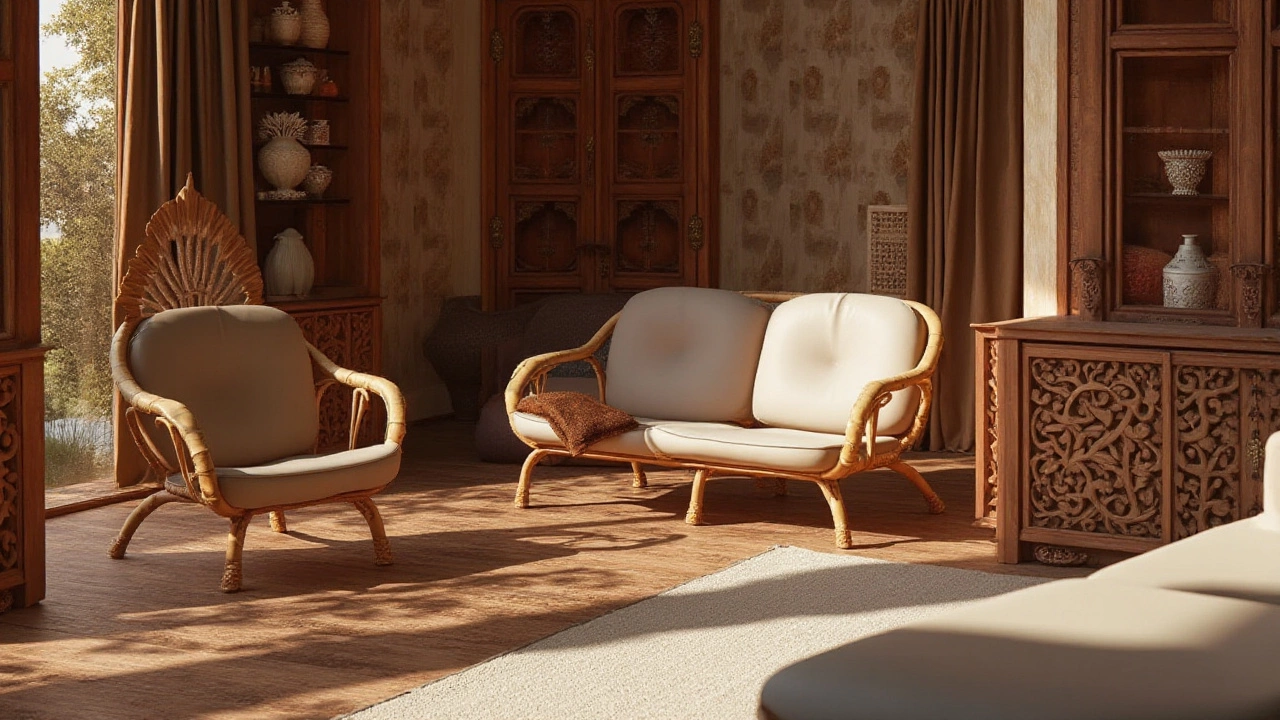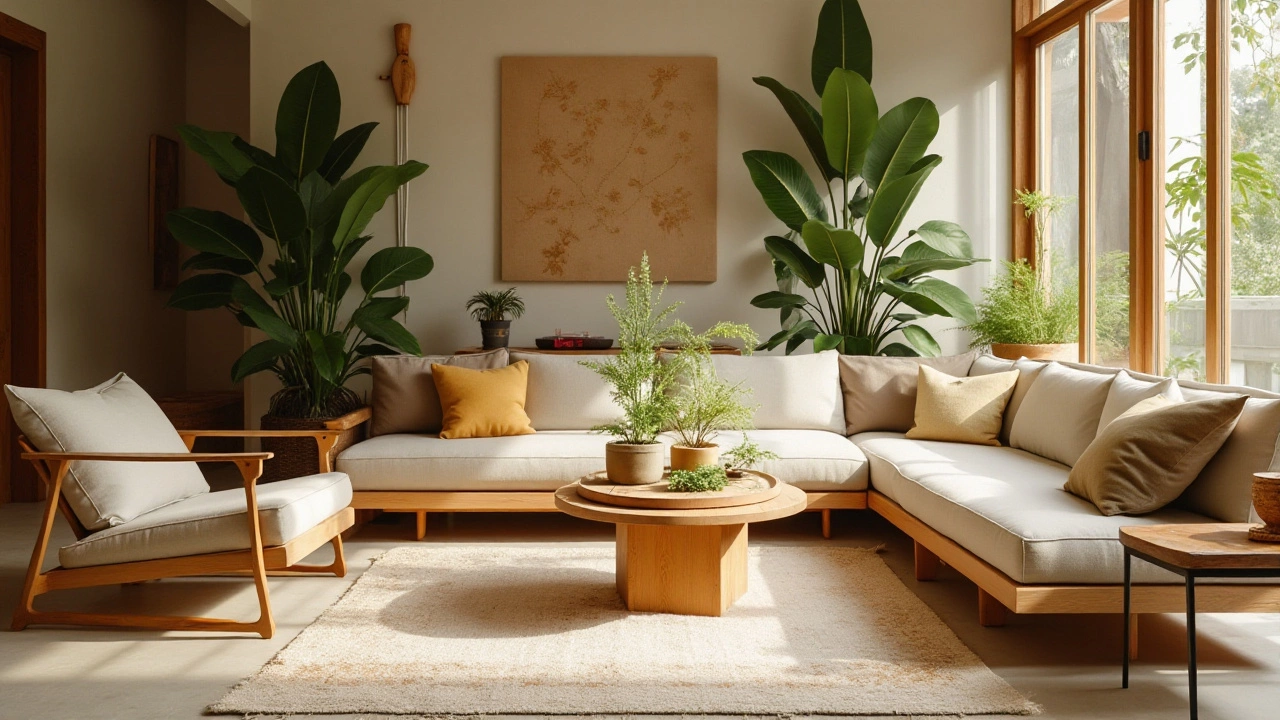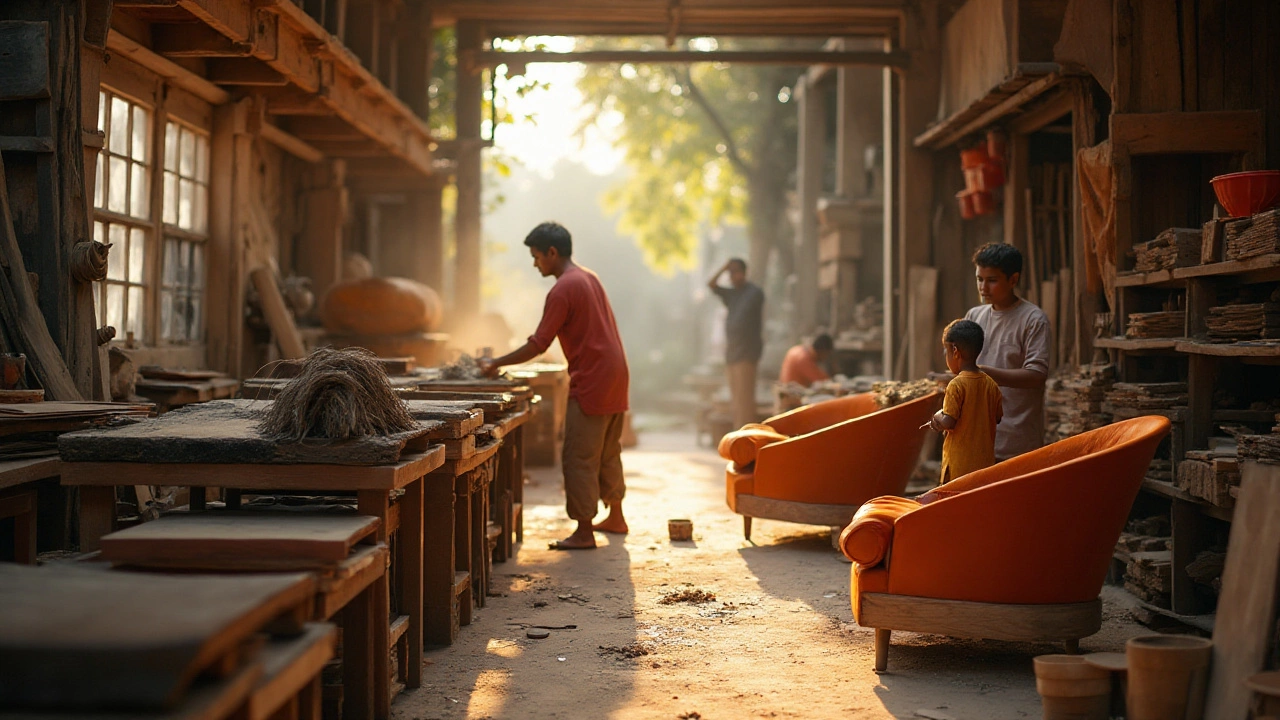In the vast landscape of furniture manufacturing in India, selecting the right material is a decision that blends tradition with modernity. The diversity of materials available reflects India's rich cultural heritage and adaptability to change. Each type of material, from classic woods to cutting-edge synthetics, offers distinct features that cater to both aesthetic tastes and functional needs.
With the country's varied climate, from humid coastal regions to arid interiors, the choice of material plays a crucial role in furniture durability and maintenance. By diving into different options available, this article aims to guide both manufacturers and consumers through a journey of discovery, revealing the ideal materials suited for Indian homes.
- Traditional Wood Options
- Modern Synthetic Materials
- Climate Considerations
- Sustainability and Trends
Traditional Wood Options
When discussing the role of traditional wood in Indian furniture, a world of history and artisanal craftsmanship unfolds. Wood has long been revered as a prime material for making furniture in India, a land known for its vast forest resources and profound connection to nature. With a palette as diverse as its culture, India showcases wood types like teak, rosewood, mango, and sheesham, each carrying its own unique set of characteristics and allure.
Teak stands at the forefront of India's furniture scene, celebrated for its robustness and longevity. This golden-brown hardwood is a popular choice due to its natural oil that helps resist water and pests. Furniture crafted from teak doesn't just stand the test of time—it ages gracefully, acquiring a classic patina over the years. But it is not just about durability; teak boasts a luxurious texture and a fine grain pattern that adds elegance to any piece.
Rosewood, with its rich hues and heavy density, is another prized material. Known locally as Dalbergia latifolia, it is appreciated for its strength and the dense grain pattern that gives furniture a distinctive look. Rosewood’s natural beauty often requires no embellishments, letting its innate charm speak through fine detailing and smooth finishes. Mango wood is also gaining popularity; it is a more sustainable and budget-friendly option. The versatility of mango wood allows intricate carvings, which is a testament to the skill of Indian craftsmen.
"Wood is universally beautiful to man. It is the most humanly intimate of all materials." – Frank Lloyd Wright
Sheesham, or Indian rosewood, should not go unnoticed when examining traditional wood choices. Its dense structure and natural sheen make it ideal for intricate carvings and ornate designs, features that thrive in Indian craftsmanship. Its resistance to decay and pests enhances its appeal for furniture that demands both artistry and resilience.
While traditional wood offers immense benefits, it also presents some challenges. The environment's impact on wood, from termite infestations to warping in high moisture, necessitates thoughtful care and maintenance. Besides, traditional wood types have sparked environmental concerns due to deforestation, inspiring a conversation about sustainability and responsible sourcing. Indian furniture makers increasingly opt for certified woods, combining tradition with responsibility.
Exploring traditional wood options for furniture is like delving into a legacy of art, utility, and resilience. Each type of wood lends itself to different aesthetic and functional needs, making the selection process deeply personal while addressing practical considerations. Whether for the sheen of teak in a colonial-style bench or the intricate carvings on a rosewood cabinet, traditional wood continues to charm Indian homes, carrying with it stories and artistry from generations past.

Modern Synthetic Materials
In recent years, furniture materials have evolved significantly, thanks to technological advancements and environmental considerations. Modern synthetic materials are becoming increasingly popular among furniture makers in India and around the world. These materials offer flexibility and durability, often at a lower cost than their natural counterparts. One of the most common synthetic materials used today is MDF, or Medium Density Fiberboard. MDF is made by breaking down hardwood or softwood residuals into wood fibers and combining them with wax and a resin binder, which are then formed into panels by applying high temperature and pressure.
MDF's smooth surface and consistent strength make it ideal for a variety of applications, including cabinetry and intricate furniture designs. It absorbs paint easily and can be cut in any direction without fracturing, opening up endless creative possibilities. Another modern favorite is plywood, which consists of thin layers of wood veneers glued together. Plywood is known for its strength and resistance to cracking, shrinking, and twisting. Manufactured in both softwood and hardwood varieties, plywood offers versatility in the production of furniture components. Its layered construction provides excellent stability, which is vital in regions with fluctuating humidity, common across India.
"Plywood's cross-grained structure provides much-needed tensile strength, combating the typical warping seen in monolithic wood panels," explains Shyam Patel, a renowned furniture designer.Subsequently, there is high-density polyethylene (HDPE), which is a tough, rigid plastic known for its high impact strength. HDPE is widely used in making outdoor furniture due to its resilience against elements such as sunlight and rain. Manufacturers who focus on outdoor furnishings prefer HDPE as it is lightweight while retaining the capacity to withstand harsh weather conditions. Furthermore, HDPE is fully recyclable, which aligns with the growing demand for eco-friendly and sustainable solutions in the India furniture market.
Additionally, tempered glass and acrylics are also gaining traction for their minimalist appeal and easy maintenance. Acrylic, in particular, is favored for its lightweight properties and can be molded into a variety of shapes. Acrylics are noted for their transparent quality, commonly used for modern dining tables and elegant display units, adding a touch of sophistication to any space. While tempered glass offers a sleek, enduring look, often used for tabletops and shelving, ensuring remarkable longevity and resistance to scratches and heat.
A study conducted by the Indian Institute of Interior Designers highlighted that consumer preference is slowly but efficiently tilting towards these synthetic alternatives. The main reasons cited were cost-effectiveness, availability, and the modern aesthetic that these materials provide. The data table below reflects the percentage increase in the use of synthetic materials over the past decade, showcasing a clear trend towards these industrial innovations:
| Year | Percentage Increase |
|---|---|
| 2010 | 12% |
| 2020 | 45% |
| 2024 | 58% |
Hence, with the continuous improvement in production technologies and design trends leaning towards clean, sleek lines, synthetic materials like MDF, plywood, HDPE, tempered glass, and acrylic are expected to dominate the future of furniture manufacturing in India. Embracing these materials aligns with consumer preferences for contemporary styles while addressing essential durability and cost efficiency.

Climate Considerations
India's diverse climate is a critical factor in determining the most suitable furniture materials. Each region presents its own environmental challenges, affecting how different materials perform over time. In coastal areas like Chennai or Mumbai, where humidity reigns supreme, furniture might be prone to swelling or warping if made from natural wood. On the other hand, places like Rajasthan, with their arid conditions, can lead to cracking and dryness in wood furniture. Thus, selecting the right material means understanding these climate influences deeply.
To combat these challenges, manufacturers often turn to engineered woods and synthetic materials as viable alternatives. Laminates, for instance, are often favored for their ability to resist moisture, preventing the damage that natural woods might suffer. Additionally, materials like MDF (Medium-Density Fiberboard) provide a more stable alternative, reducing the risks associated with humidity. Even metals are chosen for outdoor furniture due to their resistance to weather-related corrosion.
Regional Variations and Adaptations
Recognizing geographical variations is key to adapting furniture design and material choice effectively. In the northern parts of India, where seasons shift from freezing winters to scorching summers, furniture ideally needs to be versatile enough to handle extreme swings. Seasonal changes can affect material expansion and contraction, so teak wood, known for its resilience, often becomes a preferred choice due to its natural oils that resist effects from both moisture and dryness.
According to noted furniture expert Dr. Ramesh Kapoor, "The material choice in furniture is not just about aesthetics but ensuring longevity that aligns with regional climatic challenges."
For homeowners and manufacturers alike, the challenge is to balance aesthetics with functionality. Polymers and other man-made materials are gaining popularity for both indoor and outdoor settings for this reason. They require minimal maintenance across diverse climates while offering a wide range of stylistic options. For sustainable options, bamboo has emerged as a strong candidate, especially in parts of the northeastern states, offering both environmental benefits and natural climate adaptability.
Impact on Maintenance and Purchases
Climate doesn’t just influence the initial material selection, but also plays a vital role in the maintenance of furniture. Regular care like oiling for wood or rust treatment for metals can significantly increase a piece's lifespan. Additionally, informed consumers are starting to prioritize durability over immediate style, understanding that the right material choice is a long-term investment in both their lifestyle and the environment. This trend is mirrored by manufacturers, who are increasingly focusing on producing furniture that can withstand India’s varied climate, ensuring longevity and consumer satisfaction.
- Consider humidity levels before selecting materials.
- Prioritize weather-resistant materials for coastal or extreme weather regions.
- Incorporate treatments to enhance material durability.
- Balance aesthetic desires with climatic demands to choose timeless pieces.

Sustainability and Trends
As the world gravitates towards environmentally conscious living, the furniture industry in India is no exception. Consumers and manufacturers are increasingly aware of the ecological impact of their choices. As a result, there is a strong push towards sourcing materials that minimize environmental harm, such as reclaimed wood, bamboo, and rattan. Each of these furniture materials not only offers an eco-friendly option but also brings unique aesthetic and functional benefits. Reclaimed wood, for example, is celebrated for its character and history, offering each piece a distinct narrative that adds to its charm.
Bamboo, on the other hand, is fast becoming a favorite due to its rapid growth rate and versatility. It can be crafted into various forms, allowing for contemporary designs that appeal to urban sensibilities. Meanwhile, rattan's natural appeal aligns well with the growing trend of bringing natural textures indoors. Such materials not only reduce dependence on slow-growing hardwoods but also offer a refreshing break from synthetic furnishings. These trends are reflected in consumer preferences, with many favoring products that tell a story and contribute to a sustainable future.
Emerging trends in the Indian furniture market also reveal a penchant for minimalistic designs that capitalise on versatility and function. The fusion of traditional craftsmanship with modern minimalism is not just an aesthetic choice but reflects the modern consumer's lifestyle. Pieces that can serve more than one purpose or transform as needed are gaining popularity, such as extendable tables or modular sofas that maximize utility while minimizing footprint. This adaptability aligns with urban living where space is constrained but the demand for style remains uncompromised.
According to a report by the Indian Council of Forest Research and Education, sustainable material choices in furniture manufacturing can significantly reduce carbon footprint, aiding in climate change mitigation.Besides material sustainability, the production process itself is undergoing transformations. Factories are now integrating eco-friendly practices, from the use of water-based finishes and eco-friendly adhesives to renewable energy sources. Such efforts show the industry's dedication to supporting a circular economy where waste is minimized and resources are maximized. Notably, these trends signal a progressive shift as stakeholders across the spectrum — from artisans to large manufacturers — embrace practices that favor longevity, resilience, and environmental responsibility.
It's essential to note how technology is playing a pivotal role in these evolutions. Advances in design technology allow for precise shaping and cutting, reducing waste significantly. Moreover, digital platforms enable a broader reach for artisans, promoting traditional techniques on a global scale. As technology paves the way for sustainable innovation, it's clear that the future of Indian furniture is as much about honoring legacy as it is about embracing the virtues of modernity. Such duality enriches the market, drawing consumers towards a richer, more conscientious selection of furniture pieces.
